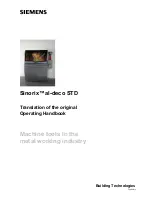
ASSEMBLY
-14-
Figure 13.
Belt tension switch.
Tensioning Belt
The switch shown in
Figure 13
controls the
sanding belt tension. When the air pressure is
connected and the switch is flipped up, the belt
will automatically tighten to the correct ten-
sion. Flipping the switch down will immediately
release the belt tension.
The belt tension will
only engage while the sander has air pressure.
Likewise, the belt tensioner may not work cor-
rectly if the air pressure is not set to the
required 75 PSI.
Pressure Rollers
The pressure rollers are factory set, but we
recommend checking them as follows to mini-
mize the potential for personal injury:
1.
Make sure that the sander is unplugged
from the power!
2.
Make sure that the platen is even with the
sanding belt rollers before continuing.
3.
Obtain a board of uniform thickness that is
at least 24" long. Place the board in the cen-
ter of the conveyor belt and position it
directly under both the front and rear pres-
sure rollers.
4.
The air pressure should be connected and
the sanding belt should be installed and ten-
sioned for this next step. Look underneath
the sanding head at the pressure rollers and
sanding belt. Slowly raise the table and con-
firm that the board makes contact with
both pressure rollers before it touches the
sanding belt.
If the board DOES NOT make contact with both
pressure rollers before touching the sanding
belt, then the pressure rollers must be adjusted.
Refer to the
Adjustments
section for step-by-
step instructions on how this can be done.
The belt must be tightened before starting
the sander!
NOTICE
















































